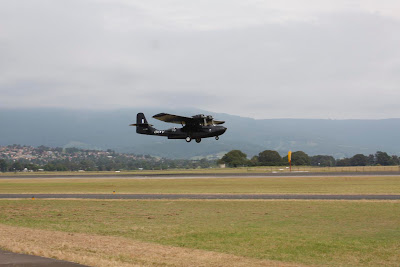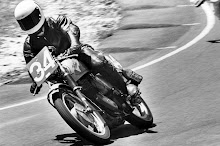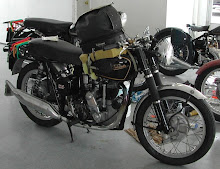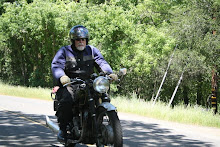Stuart Hooper hails from Buderim north of Brisbane, Queensland, Australia.
For the last three years he has spent time and money attempting to produce a Velocette that is the fastest in the world.
He made the long road trip with friends as backup crew, some 2500km plus to Lake Gairdner in South Australia.
Lake Gairdner is a salt lake where the Dry Lake Racers Australia hold speed record attempts early March each year.
Stuart's effort in 2008 was aborted due to rain washing out the meet with no racing occuring.
In 2009 he attained a speed of 133.46mph.
This year, 2010, late in the afternoon of Friday 12th March he increased this to 139.001mph, which eclipsed the 132.35mph that Bert Munroe achieved on his prewar MSS Velocette racer in New Zealand in 1971 and which was widely regarded as the fastest speed a Velocette had obtained under accurately timed conditions.
Congratulations Stuart.....
Keith Canning, President of the Velocette Owners Club of Australia and a member of Stuart crew filed this report to me tonight after he and Stuart returned to Queensland.
Australia has the Worlds Fastest Velocette.
“What a week”.
I have just flown back to Qld from the salt at Lake Gairdner after a very trying but in the end rewarding Speedweek.
Stuart Hooper achieved 139.001 mph on the last day, Friday, only half an hour before the track closed for 2010.
The record previously set by Burt Munro in 1971 at 132.35 mph in NZ.
For Stuart & the team the week certainly had its ups & downs to say the least. We arrived on Friday to find a perfect hard dry salt track, only to have rain fall on Saturday & Sunday. This was certainly a set back. Once this happened no vehicles were allowed to be moved on or to the salt & the only access to the bike & trailer already in the pits was to walk through water stretching 100 metres along the edge of the salt lake. Water was blown around the pits by high winds as well.
There was no racing on Monday, but with conditions improving, we changed the drive sprocket in anticipation of the track opening.
On Tuesday afternoon we got a run on the test track where things went well. It was the first run for the bike since last year as a complete unit.
After the drivers briefing we went straight to the GPS track where we achieved 133 mph as our highest speed. With everything going well we then lined up for a run on the main track. This enabled us to get a run on Wednesday where Stuart ran a licensing pass in the 125 mph range which is required because the bike had changed classes.
Thursday was a big day with 3 runs. The 1st at 136 mph but with high cross winds forcing him to back off to control the bike. The bike was literally tacking over like a sail boat & the back wheel moving out to compensate. After this, Stuart decided to change to the small tail for the remaining runs.
Our next run was a failure owing to the fact we had the wrong spark plug (warm up) in for the run.
The 3rd run resulted with Stuart being blown to the side of the track only missing the marker cones & backing off to stay upright. He also thought the motor was getting tired, so after lining again till the end of racing to get a position for a run the following morning, we retired to our pits to thoroughly check the bike.
We striped the Velo to a bare machine, inspecting everything we could without dismantling the engine. Things like the plug, bore, oil, timing, valve clearances etc. Everything proved OK. We raised the float level, and then went to bed knowing we only had 1 chance at most of getting a result for 2010.
Friday saw us line up early as racing was to finish about midday. The day turned out to be perfect, no cross winds & very still. We were confident of the bike now, but still ran the small tail, as cross winds usually started up at mid morning. These never eventuated but by this time we could not change the tail. We did however mix some new fuel & added 10% nitro to the methanol for an extra boost. We changed to a larger main jet to ensure it ran rich & not damage the motor.
The last run went well. The bike ran straight as an arrow & was very stable. It did run too rich however & missed & popped at the top end. It actually would have revved harder on straight methanol. Stuart ran & was timed over 2 miles. He then had the long ride back to the pits, not knowing what we the crew, already knew. He arrived to a jubilant team made up of wife Marsha, Russell Houghton & myself as well as anyone else who was nearby.
Stuart would like to thank all for their support especially the crew, friends, well wishes, fellow club members & those who made the big effort to come out to the salt.
What’s next? Develop the engine more & go faster, for sure.
I can tell you that when the Velo starts up, out on the salt, fellow competitors, crews & spectators all stop & listen to that unmistakable bark of the big single. It’s music to the ears.
Keith Canning
A beaming Stuart with his Velocette.

A special longer swinging arm fork was fabricated and fitted to the modified Velocette RS frame.


The bike in the guise it ran in the 2009 attempt. A more conventional dolphin fairing was used.
Stuart is shown on the salt during a run...



Some of the engine detail in the 700cc, 93.5mm bore by 102mm stroke, single cylinder Velocette "Venom" engine.
Including special cylinder made for it and the enlarged crankcase to take the larger bore.



Because the lake has a longer potential record strip, more and more US record breakers are coming to there as Lake Bonneville effectively becomes shorter due to salt mining etc.
Where is Lake Gairdner?
Lake Gairdner - South Australia
Home for the yearly speed Week of Dry Lake Racers Australia. http://www.dlra.org.au/
Site of the DLRA Speed Trials, Lake Gairdner is located in the State of South Australia. Largest of a group of shallow depressions west of Lake Torrens in central South Australia, 240 mi (550 kilometres) northwest of Adelaide, the State capital. It measures 100 mi (160 km) long by 30 mi wide. Lying at the base of the Eyre Peninsula, the lake is a dry salt pan (playa) intermittently filled with water. Visited in 1857 almost simultaneously by Stephen Hack and Peter E. Warburton, it is named after Gordon Gairdner, former chief clerk in the Australian Department of the Colonial Office, London.
How to get to Lake Gairdner
It is a very remote location, the nearest town of Iron Knob being some 121 kilometers (75 miles) from the turn off to the Mt. Ive Station.
Travelling time from the Victorian capital city of Melbourne is about 21 hours and Sydney, New South Wales about 25 hours.
It is about a 6 hour trip from Adelaide to Port Augusta. Most crews stay at the Big 4 Caravan Park at Pt. Augusta on the Friday night before heading out to the Lake on the Saturday. Buy beer and remaining supplies at Port Augusta, there is fuel at Iron Knob, but no LPG. From Port Augusta to Iron Knob on Highway 1 is all good grade bitumen, this takes about an hour and is 68 k's. Fuel and supplies are available at Mt. Ive, but no LPG and at slightly dearer prices.
Turn right on the dirt road just after Iron Knob turn off, you then travel 121 km to Mt. Ive Station turn off, or keep going another 8 km, past 1 cattle grid, then you come to a creek sign, turn right just before the second cattle grid. It is then 21 km past the 2 gates (Shut the gate, mate) a water well, then salt.





























































